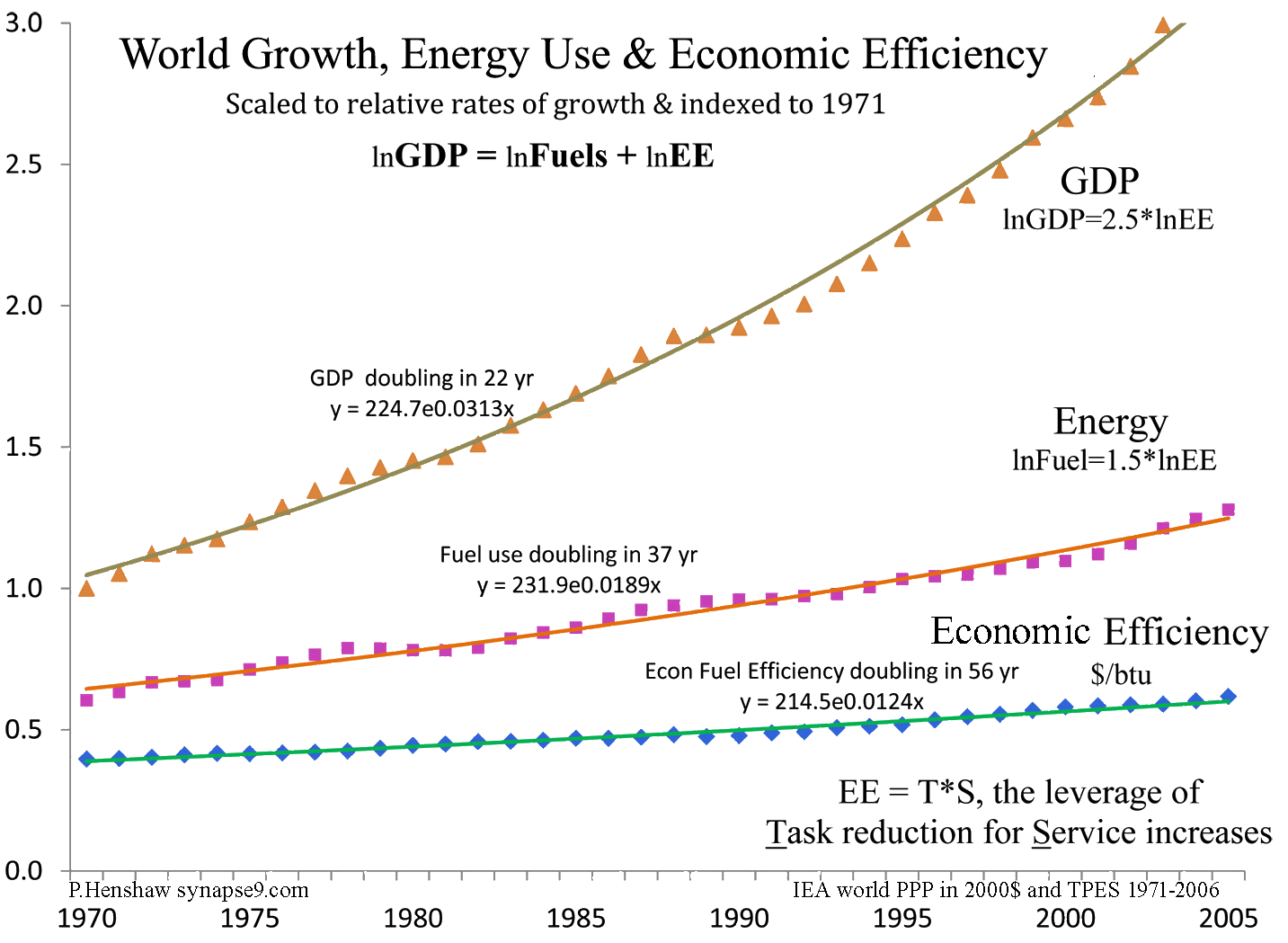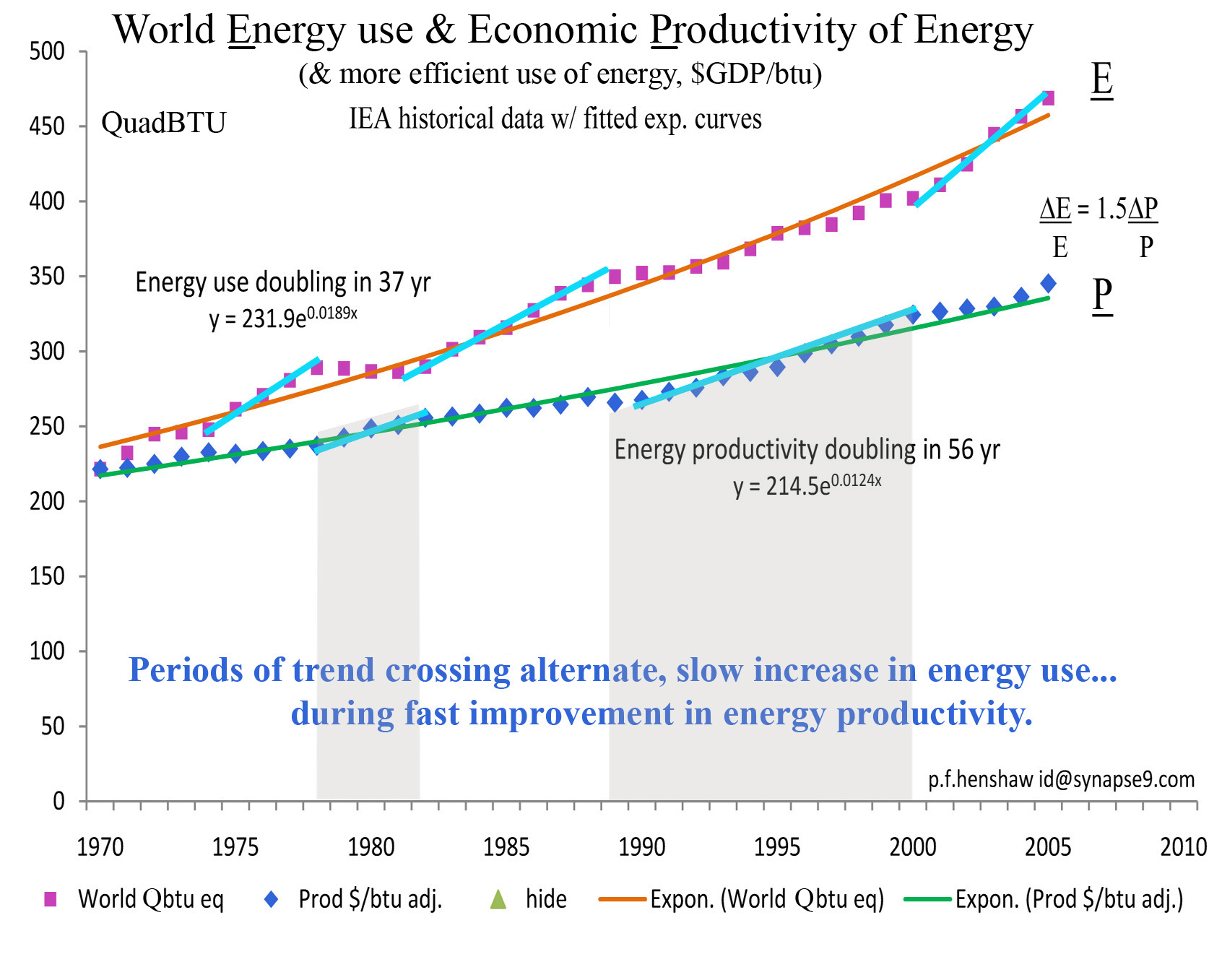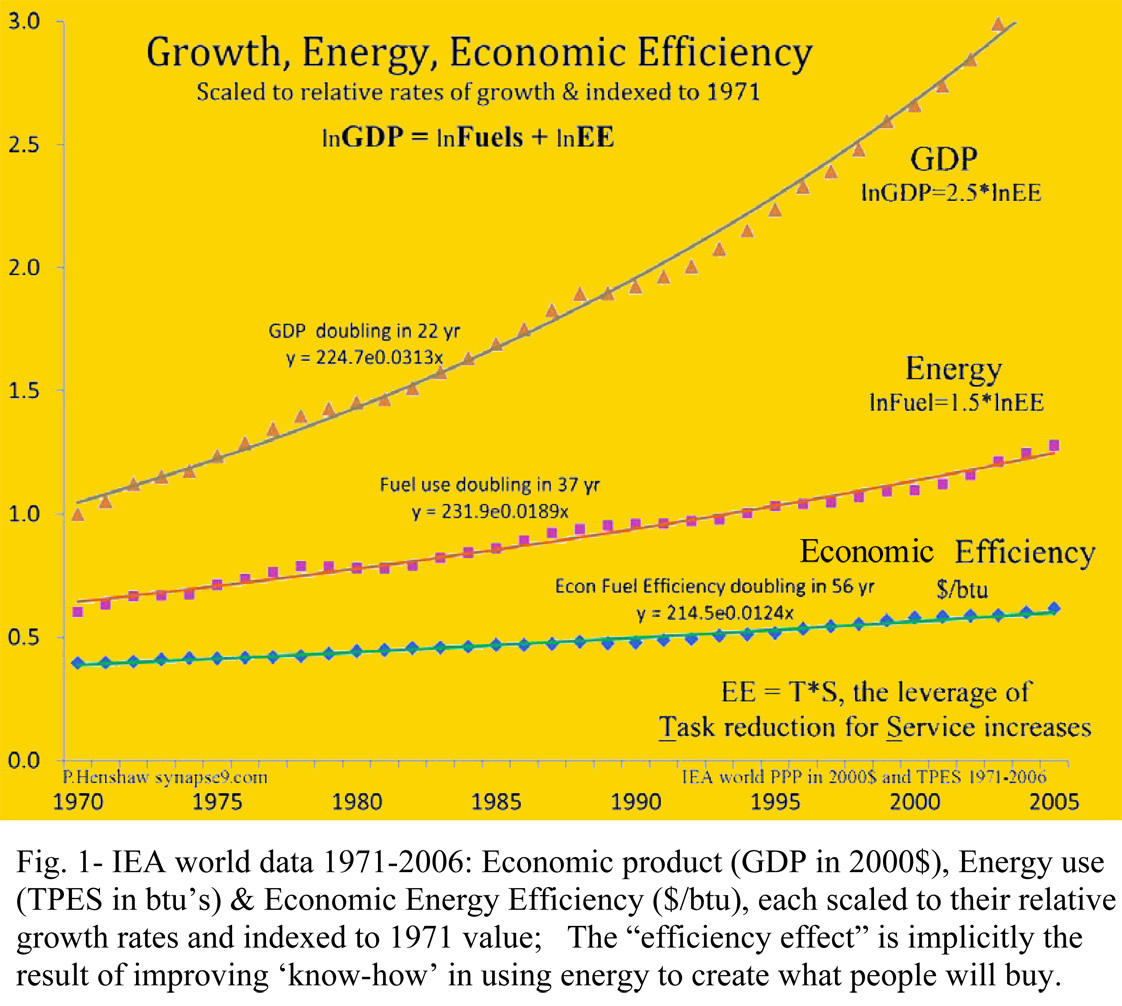Inside
Efficiency - Jevons' Effect for the economy as a whole
notes on a conference presentation 10/17/09
P. F. HenshawNote:
these findings rely on understanding what "economy
as a whole" means.
|
The basic
finding
On average, improving
economic energy efficiency increases the wealth that can be created
using energy. That makes it profitable to increase energy use.
It also reduces the energy cost for individual energy uses.
The ratio between the energy use stimulus and constraint has been a
constant. New uses created have been 2.5 times greater than resource savings.
That means that, on average, "saving energy" stimulates increasing
energy use and accelerates resource depletion worldwide.
|
|
Why Economic Efficiency Stimulates
Growth & Consumption
23 slide
presentation :
audio (starting from slide #14)
- for
BioPhysical
Economics 09,
Syracuse NY 10/16-17/2009,
- NY Times coverage
New School of Thought Brings Energy to 'the Dismal Science'
- Historical perspective by J.A. Tainter: 2008
A history of
Jevons' effect - Foreword to Polimeni, Mayumi,
Giampietro, and Alcott: The Jevons Paradox and the Myth of Resource Efficiency Improvements
|
Discussion notes
below:
1 - A current interpretation of Jevons'
original finding
1 - Outline of the reasoning
presented
2 - A list
of other interesting effects of efficiency often overlooked
3 - Why I
= P • A • T
a missing a
'• S'
for Stimulus
Blog posts
...If reducing our impacts really speeds them up!! what then??...
+
What in the world is really going on here??
+
Inside
Efficiencies a new short overview of the subject and choices
|
|
The data showing efficiency driving growth in general
 |
and in detail |
| Fig. 1 - IEA world data
1971-2006: Economic product (GDP in 2000$), Energy use (TPES in quad
btu's) and Economic Energy Efficiency ($/btu). Each
scaled to their relative growth rates and indexed to their 1971
value. The three curves seem to have a constant average
relation to each other, as if part of very same process. [updated] |
Fig. 2 - Close
coordination between rates of change in world Energy use and
efficiency. Note alternating faster and slower periods than the
trend line. Periods of rapid increase in energy use
coinciding with periods of slower efficiency improvement,
[Same data as Fig. 1, equalized at 1971] [updated] |
|
Business competition drives production,
energy use and efficiency with businesses prospering most when they
are most successful at creating efficiencies that remove barriers to
expanding production better than their competition. Thus
improving efficiency is a principal means of accelerating
consumption. Resources for development go to those
businesses that are demonstrating their competitive edge. |
The data for
the 150 year old "Jevons' effect" for the world economy is clear. As
the economy is presently operating (taken as a "black box" for
energy and efficiency inputs) improving economic efficiency has a
250% rebound effect relative to it's resource use reduction.
Innovations, on average, that save 1.0 gal of gas have the effect of
stimulating more uses equaling 2.5 gal of gas. |
Regarding Jevons' finding 150 years ago of the 'paradox' that economic
efficiency accelerates resource depletion
(quoting from my 3/23 edit of
the Wikipedia page)
The Jevons Paradox has been used to argue that energy
conservation is futile, as
increased efficiency generally
stimulates other energy uses for a net increase. However, this ignores other
benefits from increased efficiency, such as increased quality
of life. A broad assessment of benefits and liabilities is actually needed.
A global green
tax might directly restrain
energy use as it stimulates improved efficiency, for example, without just
driving energy using businesses to low tax countries. Efficiency without growth
would also extend resources briefly while the adaptation to sustainable
alternatives takes place.
The mental error most frequently made is to not combine the savings of being
more efficient with the expanded footprints of business and economic activity
that efficiencies allow and are often the motivation to start with. To leverage
large returns from small efforts small water conservation measures might be
found to allow increased regional development, for example. In the end that only
increases the number of users and the scale of development with the pressure on
the resource remaining the same. All aspects of how new methods alter their
environment need to be considered.
The economic stimulus effect Jevons first observed might not occur if efficiency
improvements were uneconomic, or if they also reduced the level of incomes
people needed to live as comfortably. Whether that would result in declining
resource footprints while improving the quality of life generally faces the same
questions. Can you discover how to do it and will the new resource potentials
created that way just provide stimulus for business to create growing uses as
usual?
Notes on my Oct 17, 2009 Talk to Charlie Hall's
Biophysical Economics meeting. The notes don't
exactly following the slides. The talk was to systems ecologists, on
efficiency in relation to the ecology of economic systems. If listening to the audio the first
slide discussed is #14 and then back to the beginning. As time runs short
the later slides for raising related subjects are only mentioned quickly.
1 - Why
efficiency improvement makes it easier to use resources and stimulates growing consumption
10/20/09
1.
Basic paradigm – economies as physical learning
systems
a)
Start from physics
first principles … like the conservation laws that imply transient complex
system development processes are required for change
(1)
Representing
natural processes with equations
(a)
neglects the
complex development processes, by which they work.
(b)
neglects their
limits and possibilities,
(2)
how to search for
the great gaps in our models
(a)
physical systems
represented as statistical equations that might recur over and over
(b)
opportunistic
learning processes that occur only once
b)
Start from what’s
naturally missing in the typical “S” curve of development. What’s missing is
the system’s environmental learning process. Slide 14
(1)
Make note of clear
switch in kind and direction of learning at inflection point!!
(2)
from multiplying
returns to dividing returns
(3)
from the past to
the future,
(4)
from pumping up to
fitting in.
2.
The data shows impacts growing faster than
efficiency, as parts of a system working as a whole.
a)
The popular
assumption is that they should go in opposite directions, but they don’t
(1)
Efficiency building
codes, creative innovation strategies, all seem to have the opposite of intended
effect.
b)
Economists have
understood this all along, but it’s mysterious why working with sustainability
planners for years and years they don’t mention that both groups are using the
same solution for opposite effects.
c)
From inside a
learning system, each part learns two things, how to reduce their effort and how
to provide more service.
(1)
Efficiency as a
measure of the “work it takes”
(2)
Productivity as the
same thing, but considered as the “service it provides”
(3)
Decreasing the
"resource it takes" increases "the work the resource can do" so to get the
impact you combine both
(4)
Difference in
looking upstream or downstream in the flows of an opportunistic economic system
3.
Efficiency doesn’t steer systems.
a)
What really steers
the direction of whole system development is what the surplus generated by that
learning is used for, with two main choices
(1)
Using it to fit
into the world,
(2)
Using it to change
the world to fit your image,
b)
Efficiency can
accelerate either,… so efficiency is more like “the gas” and does not work like
a steering wheel
(1)
presently
accelerating our increasing control of nature and maximizing resource
consumption
c)
Our mental and
cultural models of change are radically detached from the nature of physical
processes
(1)
Multiplying change
is not a natural fixed state except in imagination, and nearly all discussion in
our culture treats it as such.
(2)
We built our
institutions around the cultural experience of the former” limitless growth”
period
(3)
financial
information model represents multiplying change as a constant, but accumulates
misinformation after the inflection point ~ 1960
2 -
Inside Efficiency - A
few things about how efficiency changes
systems we often leave out…
11/4/09
1.
Efficiencies that save money or resources create savings that get
used for other things. We tend to count the subtractions but not the additions…
a.
Saved money and energy are like “printing money” and “creating
energy” not previously available, and often used for leveraging other things
b.
Say, a 10 year payback on insulating your house, uses resources to
saves and create resources that didn’t exist before… having a positive EROI
i.
First you have the added energy use and other impacts of the work
ii.
You also free up energy as a resource for others to use for powering other
uses with various impacts,
iii.
After the 10 years you have what amounts to a new source of income for
spending on other entirely new resource uses yourself,
iv.
You’ve also given the bank a profit, maybe equal to half of the cost of the
work, for it to use in multiplying more investments…
v.
the reduced impact you counted is probably equaled by (i & ii) and exceeded
by (iii & iv), thus the growth effect.
c.
When adding up impacts of spending we may count only what we see, and
miss the hidden impacts of the whole system that delivered the goods.
i.
we add up the impacts of the physical processes by which things are
made, and ignore the usually larger hidden impacts of:
1)
the employee, business operation and finance costs and impacts
2)
the embodied business development costs and impacts
3)
the resource depletion opportunity costs
2.
New efficiencies can collapse whole networks of mature technologies,
a.
Free internet media now threatens the model of professional journalism
b.
New technology used by low wage people can deny markets to formerly
well paid people.
3.
Creating efficiencies does determine what other people will use them for
a.
Saving water where that was a supply barrier to development, invites
development, expanded urban infrastructure and demand on all resources.
4.
"Do more with less" is what people want and but also and ever steeper
climb
a.
Matching the efficiencies of competitors is needed to keep investors.
b.
With unlimited resources it has the effect of sharing ways to have more
c.
With limited resources the effect is sharing ways to take more from
others.
5.
Efficiencies are a limited resource that gets ever more expensive,
a.
Finding ever greater efficiencies is a non-renewable resource, with the
same depletion points of vanishing return as diminishing EROI resources. You
can plan on their becoming too expensive to use.
b.
2nd law efficiency limits for technologies and whole systems may only
be seen in diminishing returns on investment for no other apparent cause.
6.
Efficiency has two faces, like Jekyll and Hyde, benefits that become real
dangers, like relying on increasing use of specialization or monocultures.
a.
Increasing control is decreasing tolerance. It leads to loosing
control due to complications that more tolerant designs can overlook.
b.
Environmental adaption benefits from complex diversity. Uniformity
reduces options, adds to inflexibility and instability in response to change.
c.
Accelerating coordinated change becomes accelerating uncoordinated
change due to increasingly narrow learning and delayed response.
7.
Logic makes computers very efficient for problem solving, but needing
perfect inputs to get meaningful outputs
a.
Computers treat complex questions as “garbage
in” to result in “garbage out”.
b. Nature’s way of computing is wasteful in every
step, but takes “garbage in” and produces “fruit and vegetables out” or “garbage
in” with “art and music out” using physical system complexity
as its tool.
c. The ability to sort out
undefined complexities to select what problem needs to be solved, that
computers can't do at all, seems to be an important efficiency too.
The problem with
our concept of
I = P • A • T
is that it's missing the hidden
'S'
for growth
Stimulus
Impacts
on the earth =
Population • Affluence • Technology
efficiency • Stimulus
of increasing productivity
 It's
150 year old established science, actually. Why we use
efficiencies is to simplify our tasks and become more affluent.
Our main purpose in improving organization and being more efficient with
our tasks, often with improved technology, is to
increase our productivity. That's a growth stimulus.
That makes using it as a strategy for reducing impacts completely
self-defeating. Over a century ago Stanley Jevons noticed
the effect in England when improving steam engines to use less coal
accelerated the consumption of coal, not the reverse. The added utility
and growth stimulus of
improved technology, and so the productivity of the people using it,
increased the use of the resources it was intended to conserve.
It's
150 year old established science, actually. Why we use
efficiencies is to simplify our tasks and become more affluent.
Our main purpose in improving organization and being more efficient with
our tasks, often with improved technology, is to
increase our productivity. That's a growth stimulus.
That makes using it as a strategy for reducing impacts completely
self-defeating. Over a century ago Stanley Jevons noticed
the effect in England when improving steam engines to use less coal
accelerated the consumption of coal, not the reverse. The added utility
and growth stimulus of
improved technology, and so the productivity of the people using it,
increased the use of the resources it was intended to conserve.
It was called "Jevons' paradox" because it is
counter intuitive. It's been widely discussed too.
People have simply not applied it to correcting our wishful thinking
when it comes to saving the planet from our overconsumption... Though
long recognized by many
scientists, even other scientist don't take it to heart, so it's been completely ignored in the public advocacy for
sustainability by educators, activists, media and government in
organizing,
planning and research. That's trouble! It happened
partly because people normally think by snap judgments, and "go with their intuition".
Here our intuition is dead wrong. Somehow even modern economists
have just never seemed to mention that as
a strategy for impact reduction it fails entirely. Someone needs to
research the full story of the confusion. It's both important intellectual
history and critical for getting to the bottom of why we
let our main solution for relieving our impacts on the earth be a direct
multiplier of the very problem it was intended to address.
Sustainability
does need efficiency, just not for stimulating even more growth. It
sadly does mean that the central tenet of sustainability that people around the
world are now relying on has the opposite of the intended effect on our
environmental. Look at the language of the proposals.
Even the strategies for climate change to reduce CO2 and other GHG
emissions are entirely phrased as plans to improve the
efficiency of growth. Then look at the curve. It only
means money growing faster than impacts. Ot assures that all our
kinds of impacts will keep increasing ever faster too, even if
marginally slower than the money someone is making off them. The
only way to stop adding to our impacts is to stop adding to the economy,
really. That means investors accepting their natural
fiduciary responsibility for choosing what systems the economy will
develop. They'd need to actually use their profits
from investments to no longer undermine the value of our common
investment in the earth, and invest in long term sustainability instead.
That's possible, but means that a fundamental change in the design in the economic system
is needed to make
sustainability physically feasible.
HDS consulting


 It's
150 year old established science, actually. Why we use
efficiencies is to simplify our tasks and become more affluent.
Our main purpose in improving organization and being more efficient with
our tasks, often with improved technology, is to
increase our productivity. That's a growth stimulus.
That makes using it as a strategy for reducing impacts completely
self-defeating. Over a century ago Stanley Jevons noticed
the effect in England when improving steam engines to use less coal
accelerated the consumption of coal, not the reverse. The added utility
and growth stimulus of
improved technology, and so the productivity of the people using it,
increased the use of the resources it was intended to conserve.
It's
150 year old established science, actually. Why we use
efficiencies is to simplify our tasks and become more affluent.
Our main purpose in improving organization and being more efficient with
our tasks, often with improved technology, is to
increase our productivity. That's a growth stimulus.
That makes using it as a strategy for reducing impacts completely
self-defeating. Over a century ago Stanley Jevons noticed
the effect in England when improving steam engines to use less coal
accelerated the consumption of coal, not the reverse. The added utility
and growth stimulus of
improved technology, and so the productivity of the people using it,
increased the use of the resources it was intended to conserve.